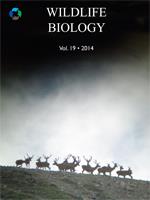Several mammals have adapted to harsh winter conditions by adopting hibernation strategies that enable them to survive periods of unfavourable environmental conditions. At northern latitudes, black and brown bears can be in a state of hibernation for up to seven months. As a result of this prolonged occupation of one small space, bears can be vulnerable to environmental and human caused disturbances. In this study, we developed a predictive model that identifies potential den habitat for black bears that can assist with management planning for industrial land development activities. We identified 40 dens (17 excavated in soil and 23 natural rock cavities) and used fine-scale information to determine how dens were positioned in forest stands. We found that bears denned in areas on mid to upper slope positions and that soil dens were located mainly in clay-loam soil complexes while rock cavity dens were either caves or cavities in boulder piles. Den location was distant from portions of the study area with relatively high road density. We then used resource selection functions to predict where bear dens might be located on the landscape. When applied to the GIS data, the averaged coefficients suggested that 3.1% of the study area had a high suitability ranking as den habitat while 9.1%, 14.6%, and 73.2% had mid, low, and limited suitability, respectively. In our study area, habitat for den sites is reasonably predictable and should be considered during the planning of industrial activities.
How to translate text using browser tools
1 August 2014
Application of a species distribution model to identify and manage bear den habitat in central British Columbia, Canada
Dexter P. Hodder,
Chris J. Johnson,
Roy V. Rea,
Andreas Zedrosser





